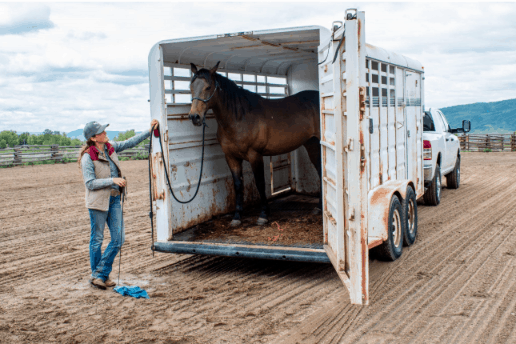
When we do anything with our horses, it is always easier to do so when there is an established trusting relationship between the two. Once this relationship exists, the horse, a natural prey animal, can work in harmony with us, its natural enemy, a predator. With this in mind, we will tackle trailering horses by using the method of natural horsemanship.
Trailering horses, as many know, is an integral part of the equine routine, essential for the transportation of our furry four-legged friends. It may seem weird to use a transportation system for an animal that was our only form of transport too long ago, but nevertheless, a modern necessity.
The Meaning of Natural Horsemanship.
Before diving right into it, it is essential to define the boundaries of the term “natural” when using it in association with our horses. In many ways, the art of natural horsemanship is ill-named when you sit down and think about it. The actual word “natural” is not necessarily the first thing that comes to mind when domesticating a prey animal by placing raw animal hide (saddles) on top of their backs and asking them to complete tasks they otherwise would never do. Keeping this in mind, horses have become a vital part of our history and have been able to form a bond with us two-leggeds like none other, creating a space for mutual understanding and benefit to develop. This is where the idea of “natural horsemanship” comes into play. Much like how a human would build a relationship with another, we do so by understanding one another through finding a mutual ground to stand up on. When this work is applied to a horse, this understanding comes from the use of body language to build a prey-to-predator relationship where dual prosperity can arise, a term coined “natural horsemanship.”
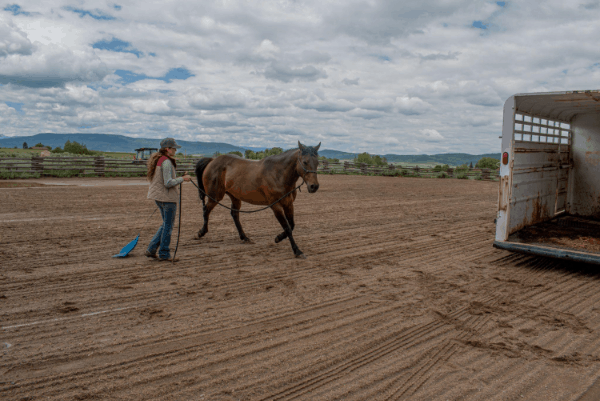
Overcoming a Horses Natural Fear of Enclosed Spaces.
So when approaching the task of trailering a horse using natural horsemanship methods, it is vital to remind ourselves of its very definition to maintain realistic goals with our horses. To put it quite simply, horses are genetically programmed to avoid an object such as a trailer, where there is only one way in, and the way out requires a predator’s help. If we think about mountain lions, for example, they bring their kill to a cave for feeding, a dark enclosed area with only one way in. Sounds pretty similar to a trailer, doesn’t it? Having said this, trailering horses is in no way an impossible feat, yet one that requires some previous knowledge of prey habits. So when we use natural horsemanship methods to do so, this simply means best helping that horse trust us enough to climb into a scary sardine can.
When approaching the scary sardine can, there exists two reasons why a horse won’t want to enter, those being out of fear or contempt for their owner. Fear being the more obvious reason, as horses are naturally bound to avoid any confined spaces that could potentially cost them their life. With this being said, this fear could also arise out of an equestrian situation where the introduction of a trailer was ill-advised or rushed. For instance, I once was tasked with colt training a yearling how to trailer, but there was one piece of essential information that slipped past me. Before arriving on the ranch, my very scared little Scarface had dramatically thrown his head in the trailer resulting in a minor injury and a significant trust issue with the sardine can. This preexisting fear arising from a bad experience meant I was dealing with a horse preconditioned to hate the trailer, making my work even more rewarding in the end. Situations such as this happen all the time, meaning we as trainers need to help our horses deal with fear-based stress before introducing a trailer.
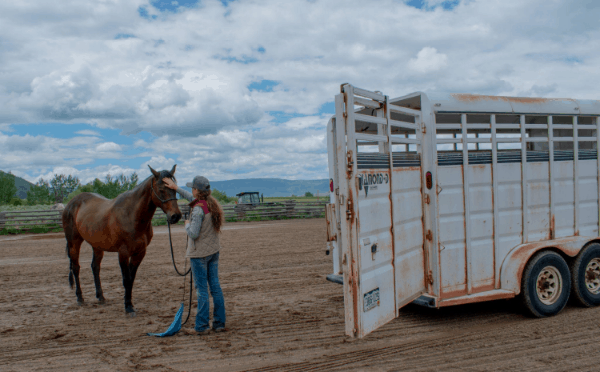
The second reason for a horse to avoid a trailer would be that of disrespect or contempt with its owner. A horse may very well be willing and able to load a trailer but has a weak relationship with their owner, resulting in the habits of pushing their humanistic buttons. With this type of resistance, it is crucial to return once again to re-establishing that trusting relationship.
Building A Trusting Relationship With Your Horse.
The building of that relationship is best acquired through the use of groundwork, where body language is the primary communication between horse and human. Here, equestrians are the most fluent in the language of the horse, as if establishing that both animals are on the same level, where mutual benefit can be born. The most important step to remember here is the power of release. Horses learn best when they know exactly what it feels like to have done something correctly by the release of pressure. So as soon as they take that step out like you asked, release your pressure and reward your obedient student. The idea behind this method is to pick your desired action followed by your pressure so that your horse doesn’t perform the undesired action. Introducing the trailer is no different, where the trailer becomes the desired action, and not loading is the undesired action. Thinking of it this way will help you as a trainer focus your cues when asking your horse to load, simplifying the task at hand.
“Horses learn best when they know exactly what it feels like to have done something correctly by the release of pressure. So as soon as they take that step out like you asked, release your pressure and reward your obedient student.“
Jordan Bastian
Getting Started.
Before asking any new horse or timid horse to load a trailer, I always ensure that I have established a trusting relationship with the animal. This can be performed all from the ground, building a working relationship based on trust, leadership, and respect. Lunge your horse around you a few times until your horse has at least their inside ear and eye on you, symbolizing that their attention is on you. From the ground also ensure that you can move their fore and hindquarters, which is a maneuver that will come in handy when trailering. Whenever you are letting your horse rest, make sure that it is when you asked and when they have come into the lunging circle and are facing you. This action is called joining up when your horse looks for rest and relaxation within the comfort of their human.
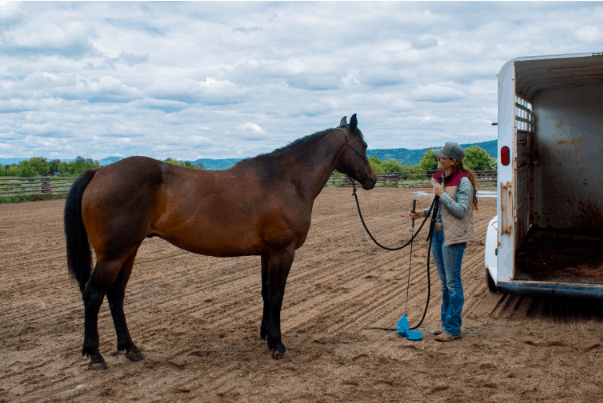
Having Access to a Trailer While Working with Your Horse Is Ideal.
If you have access to a trailer and can park it in a location where groundwork can be done, this would be an ideal setup for training trailering. Complete the same steps as you would when working the ground; the only difference now is the addition of the trailer. Work your horse around you a few times before attempting to load, then as if directing your horse over a log or jump, direct them towards the trailer.
Position yourself so that you are out of their way, preferably on the opposite side of the trailer door. Don’t quit on your horse until they either sniff, step, or even just acknowledge the trailer; that way they learn that the rest comes with the trailer. Continue pushing them towards the trailer, allowing them to sniff and paw until they are comfortable enough to make their first step up. As soon as they take a step, release all of your pressure and reward them with pets and praise.
After a few tries and walking towards the trailer and pushing them up into the trailer, your horse will eventually become more and more comfortable walking all the way inside. Once this is achieved, try to allow your horse to stand in the trailer as they will smell and check out their new surroundings. If you are using a stick and flag as an extension of your arm, this would be a perfect time to pat them down with such to help them relax in this new setting. While doing so, make sure that you are in no way a blockage for them to get out as they might become claustrophobic and stressed if under the impression of being stuck.
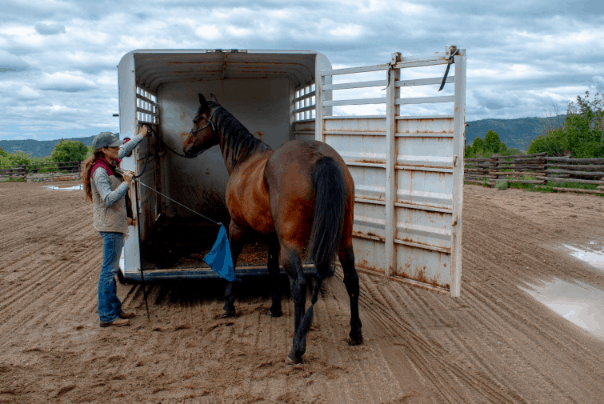
Unloading from The Trailer
Once you are confident that your horse feels more comfortable in the trailer, it is then time to unload them. When first starting to train a horse to the trailer, I would advise against the action of backing them out of the trailer. Backing out can bring unnecessary stress to an already stimulated horse, potentially causing harm to either you or them. The practice of backing out of a trailer is only essential if utilizing a two-horse stalled trailer, which in most cases will include a ramp for easy unloading. Instead of backing, allow space for your horse to turn around and walk slowly out of the trailer. Ensure that you are the first person out, positioning yourself back at that doorless side to provide sufficient space for your humble steed. Once your horse has dismounted, always bring them back into you as if in a lunging circle for that join-up moment. This extra step, although seemingly tedious, helps your horse to always associate the resting with you, looking to you for the next command.

When trailering a horse, there are a lot of things that could go wrong, so if at any point you feel unsafe or your horse is at a vulnerable position, safely remove both of you from the trailer to regain your thoughts. There is no rush when working with a horse, so take your time and don’t be afraid to take a few extra cautionary steps. By following these natural horseman tips, you’ll be loaded up heading down the road in no time.
